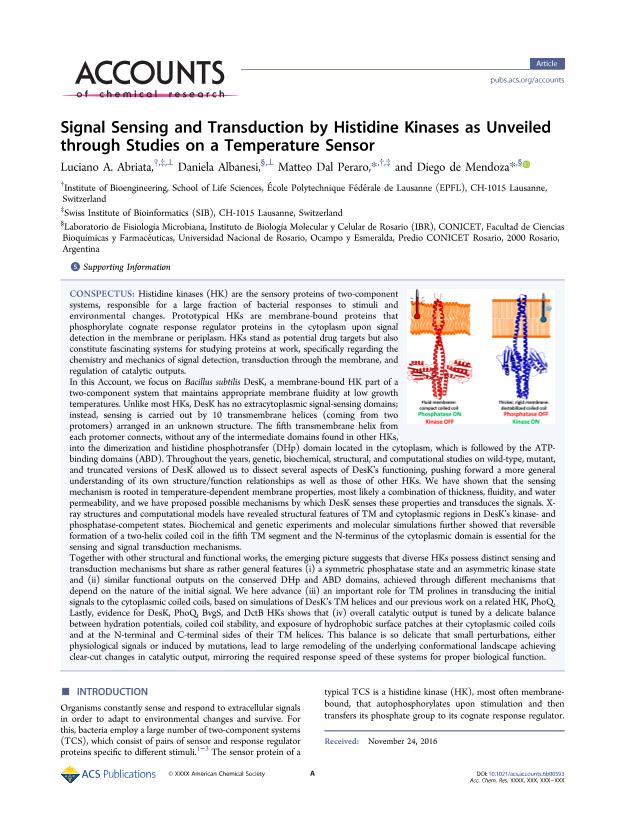Artículo
Signal Sensing and Transduction by Histidine Kinases as Unveiled through Studies on a Temperature Sensor
Fecha de publicación:
06/2017
Editorial:
American Chemical Society
Revista:
Accounts of Chemical Research
ISSN:
0001-4842
Idioma:
Inglés
Tipo de recurso:
Artículo publicado
Clasificación temática:
Resumen
Histidine kinases (HK) are the sensory proteins of two-component systems, responsible for a large fraction of bacterial responses to stimuli and environmental changes. Prototypical HKs are membrane-bound proteins that phosphorylate cognate response regulator proteins in the cytoplasm upon signal detection in the membrane or periplasm. HKs stand as potential drug targets but also constitute fascinating systems for studying proteins at work, specifically regarding the chemistry and mechanics of signal detection, transduction through the membrane, and regulation of catalytic outputs. In this Account, we focus on Bacillus subtilis DesK, a membrane-bound HK part of a two-component system that maintains appropriate membrane fluidity at low growth temperatures. Unlike most HKs, DesK has no extracytoplasmic signal-sensing domains; instead, sensing is carried out by 10 transmembrane helices (coming from two protomers) arranged in an unknown structure. The fifth transmembrane helix from each protomer connects, without any of the intermediate domains found in other HKs, into the dimerization and histidine phosphotransfer (DHp) domain located in the cytoplasm, which is followed by the ATP-binding domains (ABD). Throughout the years, genetic, biochemical, structural, and computational studies on wild-type, mutant, and truncated versions of DesK allowed us to dissect several aspects of DesK’s functioning, pushing forward a more general understanding of its own structure/function relationships as well as those of other HKs. We have shown that the sensing mechanism is rooted in temperature-dependent membrane properties, most likely a combination of thickness, fluidity, and water permeability, and we have proposed possible mechanisms by which DesK senses these properties and transduces the signals. X-ray structures and computational models have revealed structural features of TM and cytoplasmic regions in DesK’s kinase- and phosphatase-competent states. Biochemical and genetic experiments and molecular simulations further showed that reversible formation of a two-helix coiled coil in the fifth TM segment and the N-terminus of the cytoplasmic domain is essential for the sensing and signal transduction mechanisms. Together with other structural and functional works, the emerging picture suggests that diverse HKs possess distinct sensing and transduction mechanisms but share as rather general features (i) a symmetric phosphatase state and an asymmetric kinase state and (ii) similar functional outputs on the conserved DHp and ABD domains, achieved through different mechanisms that depend on the nature of the initial signal. We here advance (iii) an important role for TM prolines in transducing the initial signals to the cytoplasmic coiled coils, based on simulations of DesK’s TM helices and our previous work on a related HK, PhoQ. Lastly, evidence for DesK, PhoQ, BvgS, and DctB HKs shows that (iv) overall catalytic output is tuned by a delicate balance between hydration potentials, coiled coil stability, and exposure of hydrophobic surface patches at their cytoplasmic coiled coils and at the N-terminal and C-terminal sides of their TM helices. This balance is so delicate that small perturbations, either physiological signals or induced by mutations, lead to large remodeling of the underlying conformational landscape achieving clear-cut changes in catalytic output, mirroring the required response speed of these systems for proper biological function.
Palabras clave:
Histidine Kinase
,
Signal Sensing
,
Signal Transduction
,
Desk
,
Bacillus Subtilis
Archivos asociados
Licencia
Identificadores
Colecciones
Articulos(IBR)
Articulos de INST.DE BIOLOGIA MOLECULAR Y CELULAR DE ROSARIO
Articulos de INST.DE BIOLOGIA MOLECULAR Y CELULAR DE ROSARIO
Citación
Abriata, Luciano Andres; Albanesi, Daniela; Dal Peraro, Matteo; de Mendoza, Diego; Signal Sensing and Transduction by Histidine Kinases as Unveiled through Studies on a Temperature Sensor; American Chemical Society; Accounts of Chemical Research; 50; 6; 6-2017; 1359-1366
Compartir
Altmétricas




